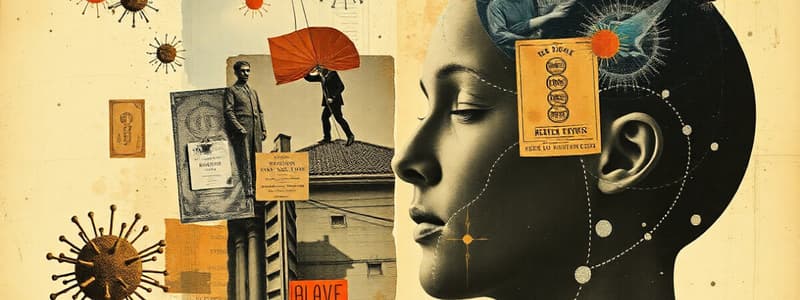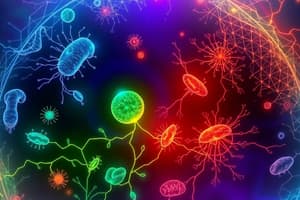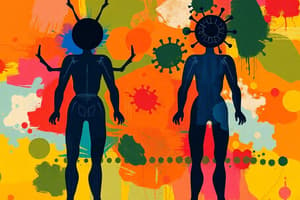Podcast
Questions and Answers
Which of the following must occur for pathogens to cause disease in humans?
Which of the following must occur for pathogens to cause disease in humans?
- Attachment to host cells, rapid reproduction, and toxin production.
- Direct injection into the bloodstream, disruption of cellular processes, and immune suppression.
- Entry through a portal, penetration of the surface, and evasion of the body's defenses. (correct)
- Mutation to overcome immune responses, biofilm formation, and nutrient acquisition.
Innate and adaptive immunity always happen sequentially, with innate immunity preceding the adaptive response.
Innate and adaptive immunity always happen sequentially, with innate immunity preceding the adaptive response.
False (B)
What term characterizes the body's defenses that are present at birth and are nonspecific?
What term characterizes the body's defenses that are present at birth and are nonspecific?
innate immunity
The body's first line of defense relies on __________ to prevent pathogen entry.
The body's first line of defense relies on __________ to prevent pathogen entry.
Match the barrier type with its example:
Match the barrier type with its example:
Which structural barrier contains epithelium both internally and externally?
Which structural barrier contains epithelium both internally and externally?
Epithelial surfaces are static and do not undergo regular mitosis.
Epithelial surfaces are static and do not undergo regular mitosis.
What type of junctions are present between epithelial cells that contributes to the structural barrier?
What type of junctions are present between epithelial cells that contributes to the structural barrier?
__________ movement involves physically removing microbes, such as through coughing or swallowing.
__________ movement involves physically removing microbes, such as through coughing or swallowing.
How does fluid movement act as a mechanical barrier against pathogens?
How does fluid movement act as a mechanical barrier against pathogens?
Keratin provides moisture to the skin, facilitating microbial growth.
Keratin provides moisture to the skin, facilitating microbial growth.
What antibacterial agent is found in tears and saliva?
What antibacterial agent is found in tears and saliva?
__________ secreted by sebaceous glands lowers skin pH, inhibiting bacterial growth.
__________ secreted by sebaceous glands lowers skin pH, inhibiting bacterial growth.
Match each chemical barrier with its primary mechanism of action:
Match each chemical barrier with its primary mechanism of action:
What refers to the phenomenon where a host is genetically immune to the diseases of other hosts?
What refers to the phenomenon where a host is genetically immune to the diseases of other hosts?
All microbes have the appropriate receptors and ability to attack all host cells.
All microbes have the appropriate receptors and ability to attack all host cells.
What is the general term for the adjustments normal flora make to adhere to body surfaces?
What is the general term for the adjustments normal flora make to adhere to body surfaces?
Adhesins bind to __________ on the surface to allow for attachment.
Adhesins bind to __________ on the surface to allow for attachment.
To what does the lock-and-key model of microbial attachment refer?
To what does the lock-and-key model of microbial attachment refer?
The second line of defense is considered the primary barrier and is always the first to respond.
The second line of defense is considered the primary barrier and is always the first to respond.
Is the second line of defense part of innate or adaptive immunity?
Is the second line of defense part of innate or adaptive immunity?
The second line of defense consists of four components, all of which have some involvement with the __________.
The second line of defense consists of four components, all of which have some involvement with the __________.
What is the primary goal of inflammation?
What is the primary goal of inflammation?
The four signs of inflammation are redness, heat, swelling, and itching.
The four signs of inflammation are redness, heat, swelling, and itching.
Aside from the four signs of inflammation, what is considered the fifth sign?
Aside from the four signs of inflammation, what is considered the fifth sign?
During inflammation, changes to blood vessels lead to __________ and edema.
During inflammation, changes to blood vessels lead to __________ and edema.
What is the main role of vasodilation during inflammation?
What is the main role of vasodilation during inflammation?
Swelling always has positive effects, enhancing tissue repair.
Swelling always has positive effects, enhancing tissue repair.
What is the process by which neutrophils and monocytes are delivered to the site of infection during inflammation?
What is the process by which neutrophils and monocytes are delivered to the site of infection during inflammation?
During inflammation, leukocytes squeeze between vessel wall cells, a process called __________.
During inflammation, leukocytes squeeze between vessel wall cells, a process called __________.
Flashcards
First Line of Defense
First Line of Defense
The body's first line of defense includes innate barriers that prevent pathogens from entering.
Epithelial Surfaces
Epithelial Surfaces
Skin and mucous membranes impede entry of pathogens.
Mechanical Barriers
Mechanical Barriers
Physical removal of microbes via movement.
Chemical Barriers
Chemical Barriers
Signup and view all the flashcards
Genetic Barriers
Genetic Barriers
Signup and view all the flashcards
Second Line of Defense
Second Line of Defense
Signup and view all the flashcards
Goals of Inflammation
Goals of Inflammation
Signup and view all the flashcards
Signs of Inflammation
Signs of Inflammation
Signup and view all the flashcards
Edema
Edema
Signup and view all the flashcards
Redness
Redness
Signup and view all the flashcards
Fever
Fever
Signup and view all the flashcards
Chemotaxis
Chemotaxis
Signup and view all the flashcards
Interferon
Interferon
Signup and view all the flashcards
Complement
Complement
Signup and view all the flashcards
Study Notes
- Chapter 15 is about Immunity
Overview of Body Defenses
- Pathogens can cause diseases in humans
- Pathogens must access a portal of entry.
- Pathogens must penetrate the surface of cells or blood.
- Pathogens must evade the body's defense.
- The body as a two broad categories of defense, innate and adaptive.
- Innate defenses lack memory, are present at birth, and are nonspecific.
- Adaptive defenses have memory, develop later in life, and are specific.
- Both innate and adaptive defenses are needed to be fully protected.
- The first line of defense consists of innate barriers.
- The second line of defense consists of the innate immune response.
- The third line of defense consists of the adaptive immune response.
Body's First Line of Defense
- The environment on the surface inhibits microbes from causing infection.
- Nutrients, temperature, and pH are factors in this environment.
- Barriers are what microbes must pass to cause disease.
- Barriers are nonspecific and are the first line of defense.
- Structural, mechanical, chemical, and genetic barriers comprise the first line of defense.
Structural Barriers
- Epithelium is found on the surface both internally and externally.
- Two types of epithelial surfaces are skin and mucous membranes.
- In both instances, the epithelium constantly undergoes mitosis and replaces sloughed layers.
- Microbes attached to the epithelium are lost.
- There are tight junctions between epithelial cells.
Mechanical Barriers
- Mechanical barriers involve movement and physically remove microbes.
- Mucociliary movement is found lining the nose and throat; microbes trapped in mucus are coughed or swallowed.
- Fluid movement, like the flow of urine, saliva, and tears, continually flushes microbes from the surface.
Chemical Barriers
- Chemical barriers are agents produced by cells on the surface.
- Keratin keeps skin dry and waterproof.
- Perspiration is secreted by sweat glands.
- Salt inhibits the growth of pathogens.
- Lysozymes are made by saliva and tears and are antibacterial.
- Sebum is secreted by sebaceous (oil) glands.
- Sebum lowers skin pH to inhibitory levels for many bacteria.
- Lowering the pH with hydrochloric acid (HCL) in the stomach has a similar effect.
Genetic Barriers
- A host can be genetically immune to diseases of other hosts.
- Microbes may lack the appropriate receptors or the ability to attack host cells.
- This specificity is referred to as species specificity.
- Examples of species specificity include HIV versus FIV and Ebola virus versus heartworms.
Normal Flora
- Normal flora can survive barriers with several adjustments to attach to the surface
- The attachement is with adhesins
- Adhesins bind to their complimentary receptor molecules
- Lock and key fit for adhesins and receptors
Practice Examples
- Salt: integument, chemical
- Lysozymes: respiratory, chemical
- Mucociliary movement: respiratory, mechanical
- HCL: digestive, chemical
- Urine: urinary, chemical
- Lactobacillus: epidermis
- Mitosis: integument, structural
- Pinworms: intestinal, genetic
- Vomiting: digestive, mechanical
- Structural barriers are in the mouth, nose, skin, intestinal, urinary, and reproductive tracts
- Chemical, mechanical, and genetic barriers are in all of the same places
The Second Line of Defense
- Occurs when pathogens penetrate the skin or mucous membranes, and get passed initial barriers.
- The second line of defense is still part of the nonspecific innate immune response.
- It consists of four components, each involved with the blood: Inflammation, Phagocytosis, Interferon, and Complement.
Inflammation
- "Itis" suffix
- Inflammation is a nonspecific response to tissue damage from various causes, such as trauma, wounds, or burns.
- The goal of inflammation is to remove the agent causing inflammation, to keep damage local, and to allow for healing.
- Inflammation is characterized by redness, heat, swelling, and pain.
- A fifth sign of inflammation is the loss of function due to pain and swelling.
- The three sequential events that occur following injury are vascular changes, edema (local), and fever (systemic).
- Vascular changes are triggered by chemicals released after an injury.
- Major chemicals include Bradykinins, Prostaglandins, Leukotrienes, and Histamine.
- Vasodilation produces redness and localized heat associated with inflammation.
- Blood-clotting proteins are delivered to the injury site, along with leukocytes.
- Edema, or swelling, can occur from some of the same chemicals that lead to increased permeability.
- There is an increased pressure due to more blood
- Swelling dilutes toxins, but can also apply pressure to nearby nerves.
- Neutrophils and monocytes are delivered to the site of infection.
- These are recruited by chemotactic factors.
- They squeeze between cells of the vessel wall and enter the site of infection with Diapedesis
- Phagocytosis occurs allowing for tissue repair and removal of pathogens (if present).
Phagocytosis
- Phagocytosis can be divided into five stages.
- Chemotaxis is the recognition of invaders due to signal molecules on the microbe surface.
- Ingestion involves membrane extensions that surround microbes, forming a phagosome.
- Fusion occurs when lysosomes fuse with the phagosome creating a phagolysosome.
- Killing involves digestive enzymes in the lysosome that destroy the microbe.
- Elimination occurs when debris is discharged out of the cell.
Fever
- 107 degree fever if microbes are present
- Fever is a systemic factor
- Results when pyrogens trigger the hypothalamus to increase the body's core temperature
- Types of pyrogens exogenous, like bacterial toxins, and endogenous, like released by phagocytes
- Fever makes the environment less hospitable for the pathogen and inhibits growth of microbe and enhance phagocytosis
Chemical Defenses
- Viruses don't reproduce on their own, they need our cells
- Chemical defenses include Interferon
- Proteins are released by host cells to nonspecifically inhibit the spread of viral infections
- It usually inhibits reproduction
- It is released by a cell onced infected to protect neighboring cells
Complement
- A chemical defense which is a Set of serum proteins designated numerically according to their order of discovery
- There are 3 primary effects:
- C3a and C5a cause inflammation
- C3b causes opsonization
- C5b-9 causes MAC/Cytoloysis
- Some microbes produce Surface Proteins that interfere with direct contact with phagocytes
- Those surface proteins can be unique however and allow for attack by the Third Line of Defense
Studying That Suits You
Use AI to generate personalized quizzes and flashcards to suit your learning preferences.




